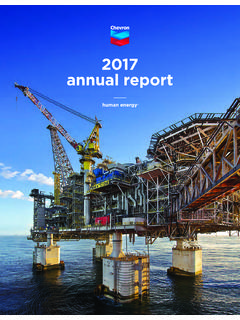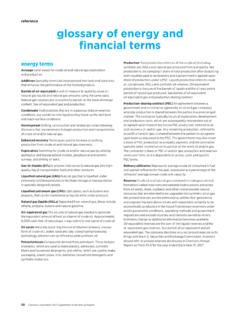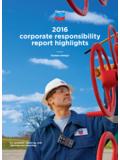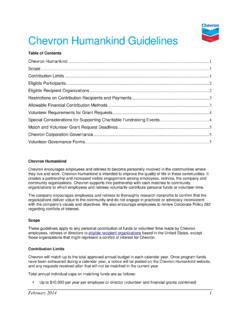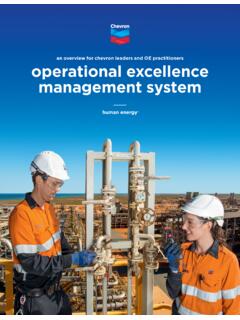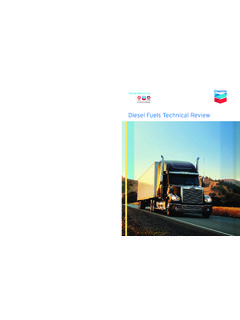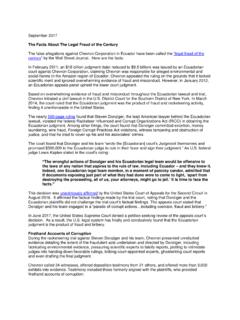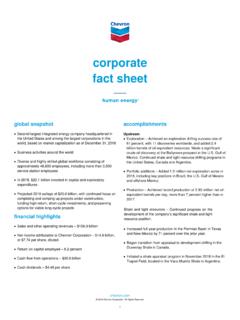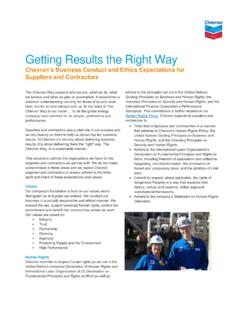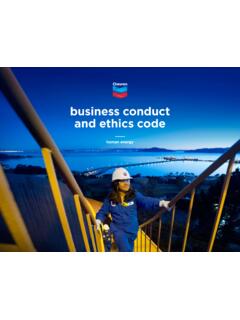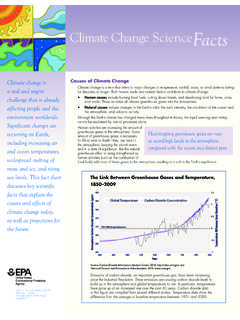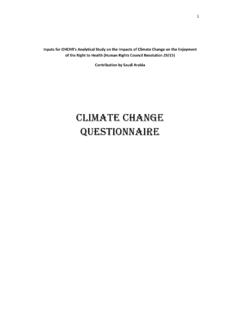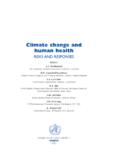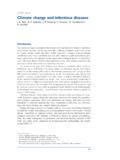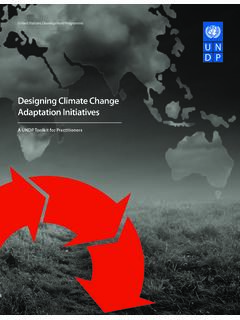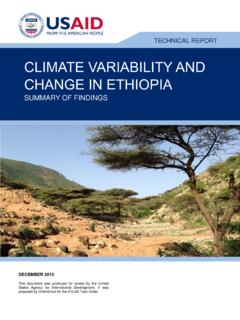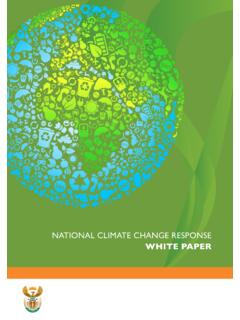Transcription of 2021 Climate Change Resilience Report - Chevron …
1 Climate Change Resilience advancing a lower carbon future table of contents 1 chairman's letter 3 executive summary delivering long-term value in a paris-aligned future 5 section 1: governance framework continuing a reliable and disciplined oversight approach 9 section 2: risk management assessing and managing transition and physical risks 12 section 3: strategy positioning for higher returns, lower carbon 38 section 4: our portfolio advancing to win in a lower carbon future 58 section 5: metrics aligning to TCFD, API, and SASB. 71 section 6: about this Report a view from our lead director The Board oversees Chevron 's performance and manage ment of various environmental, social, and governance matters with a commitment to understanding and responding to the feedback of our investors and stakeholders. When we meet with investors and other stakeholders, Chevron 's approach to Climate Change and the energy transition is an important part of the dialogue.
2 At this year's Annual Meeting of Stockholders, the level of support for Climate -related proposals indicated investors'. expectations for additional information and action. To be responsive, we have updated this year's Climate Change Resilience Report with new details about our approach to Scope 3 emission targets and our aspiration We are confident in Chevron 's to be net zero in Upstream Scope 1 and 2 emissions. ability to deliver higher We believe the future of energy will be lower carbon, returns and lower carbon.. and we intend to be a leader in that future.. Dr. Ronald D. Sugar Lead Director Climate Change Resilience : Advancing a lower carbon future October 2021. chairman's letter Transitioning to a lower carbon future provides opportunity for our Company and our customers. Essential industries that have helped build modern society, like transportation, agriculture, and manufacturing, desire to find viable ways to lower the carbon intensity of their operations.
3 Our work to create fuels of the future like hydrogen, renewable diesel, and sustainable aviation fuel seeks to lower the carbon intensity of these products and support our customers' efforts to reduce their greenhouse gas emissions. Opportunity also exists for surface and subsurface storage of carbon, a critical enabler of global net zero ambitions. Our strategy is straightforward: Be a leader in efficient and lower carbon production of traditional energy, in high demand today and for years to come, while growing low-carbon businesses that will be a bigger part of the future. When the Paris Agreement went into effect in 2016, the carbon intensity of our oil production was near the global industry average. Since that time, we've taken steps to reduce our Upstream Scope 1. and 2 carbon intensity, and in 2020, we achieved first-quartile performance for both oil and gas. Earlier this year, we established 2028 carbon-intensity targets, aligned with the second Paris Agreement stocktake.
4 To communicate our progress in lowering the overall carbon intensity of our traditional operations and Solutions start with problem solving, growing lower carbon business lines to help address Scope 3. emissions, we are introducing a portfolio carbon-intensity metric. which is exactly what the people This approach will measure the full value chain carbon intensity of of Chevron do and what we have our entire business. We are also introducing a net zero aspiration excelled at for over 140 years. for Upstream Scope 1 and 2 emissions. We believe we have a competitive advantage to deliver carbon solutions that are good In the four years since publishing our first Climate risk disclosure, for our stockholders and all stakeholders. conversations about Climate have intensified, innovation and technology advancement has accelerated, and the energy system As a company of problem solvers, we look to the future of energy that underpins our global economy has continued to evolve.
5 With optimism, believing it to be essential to human progress. So have we. This Report offers further information and insights about our strategy, the steps we're taking to advance a lower carbon future, Investors, partners, and employees frequently ask what the future and the reasons we believe this is an exciting time to be in the of energy holds, what it means for our Company, and how we business of energy. can work to help address Climate Change . Solutions start with problem solving, which is exactly what the people of Chevron do Thank you, and what we have excelled at for over 140 years. Achieving Change at scale requires partnership and collaboration throughout the energy system. It calls for advancements in science, engineering, and infrastructure; leaps in technology; Michael K. Wirth and smart evolution of policy. Succeeding in this future means Chairman of the Board and continuing to make energy ever cleaner and to bring all of Chief Executive Officer society forward affordable and reliable on a global scale.
6 October 2021. Climate Change Resilience : Advancing a lower carbon future October 2021. 1. advancing a lower carbon future eliminating enabling net zero 2050 for upstream emissions reductions scope 1 and 2 emissions of 30 mmtpa CO e by 2028. carbon aspirations pages 38, 50, 62. capital allocation pages 40, 50 54. $2B. by 2028 in carbon- $8B. by 2028 in low- reduction projects carbon investments carbon intensity low-carbon business 2028 targets: 2030 targets: targets pages 44, 46, 48 52, 59 61. portfolio carbon intensity (scope 1, 2, and 3) renewable fuels 71 g CO2e/MJ 100 mbd upstream carbon intensity hydrogen*. (scope 1 and 2). 150 mtpa 24 kg CO e/boe refining carbon intensity carbon capture and offsets (scope 1 and 2) 25 mmtpa 36 kg CO2e/boe MJ = megajoules boe = barrels of oil-equivalent mbd = thousands of barrels per day mtpa = thousands of tonnes per annum mmtpa = millions of tonnes per annum * Chevron 's approach to hydrogen envisions the use of green, blue, and gray hydrogen.
7 For more information, see page 51. policy pages 43, 58. transparent reporting carbon pricing This Report contains forward-looking statements relating to Chevron 's operations that are based on management's current expectations, estimates, and projections. For more information, see page 72. Climate Change Resilience : Advancing a lower carbon future October 2021. 2. executive summary At Chevron , we believe the future of energy is lower carbon, and pursues the energy future. Most published outlooks conclude we support the global net zero ambitions of the Paris Agreement. that fossil fuels will remain an important part of the energy system This Report builds on our previous four reports and has updates for years to come, and that the energy mix will include increasingly throughout, including key updates to pages 32 44 to reflect our lower carbon sources. As part of our strategic planning process, response to stockholders on net zero and our contributions to we use models and internal analysis to forecast demand, energy support our customers in addressing their emissions (Scope 3).
8 Mix, supply, commodity pricing, and carbon prices all of which include assumptions about future policy, such as those that may be implemented in support of the Paris Agreement's goal of holding reliable and disciplined oversight the increase in the global average temperature to well below Our governance structure calls for Chevron 's full Board of Directors 2 C above pre-industrial levels and pursuing efforts to limit the and executive leadership to exercise their oversight responsibilities temperature increase to C above pre-industrial levels.. with respect to potential Climate Change related risks and energy- transition opportunities. This oversight is executed through In 2020, more than 60 percent of our total Scope 1 and 2 equity regular engagement by the full Board of Directors and also through greenhouse gas (GHG) emissions ( , participating share of deeper, focused engagement by all Board committees. This occurs emissions both from facilities that Chevron operates and from primarily through the Board's Public Policy and Sustainability our nonoperated joint ventures) were in regions with existing or Committee, as well as the Board's Management Compensation, developing carbon-pricing policies.
9 * In this environment, and into a Audit, and Nominating and Governance Committees. At the future likely to include additional lower carbon policies, we seek to executive level, we manage potential Climate Change related find solutions that are good for society and good for investors. risks and energy-transition opportunities through the Enterprise Leadership Team and the Global Issues Committee, each of which We use carbon prices and derived carbon costs in business meets regularly throughout the year. We periodically reassess planning, investment decisions, impairment reviews, reserves our governance structure to enable Chevron to maintain a Board calculations, and assessment of carbon-reduction and new composition and governance frame work that is effective for energy opportunities. We believe that our asset mix and actions managing the Company's per formance and risks as we deliver in new energies enable us to be flexible in response to potential value to our investors.
10 Changes in supply and demand, even in lower carbon scenarios like the International Energy Agency's (IEA) Net Zero by 2050. (NZE 2050) scenario or under higher-emissions scenarios like the risk assessment and management Intergovernmental Panel on Climate Change AR5 Representative Concentration Pathway that models a hypothetical upper We face a broad array of risks , including physical, legal, policy, bound of physical risks . We believe the likelihood of either technology, market, and reputational risks . We utilize an scenario is remote and do not rely on either scenario in our enterprisewide process to assess major risks to the Company current business planning. and seek to apply appropriate mitigations and safeguards. As part of this process, we conduct an annual risk review with executive leadership and the Board of Directors and assess success in a lower carbon future our risks , safeguards, and mitigations. Affordable, reliable, ever-cleaner energy is essential to achieving a more prosperous world.
